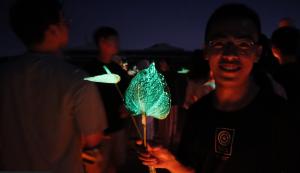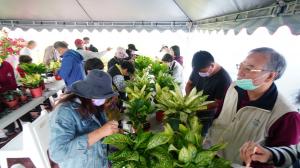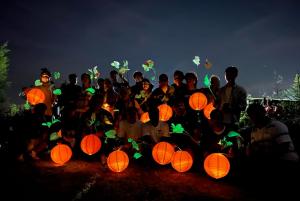Glowing Anthuriums Illuminate Taiwan’s Rural Regeneration: Fusing Art, Technology, and Climate Action
Bioluminescent Anthuriums merge art, tech & SEPLS to boost rural regeneration, climate action & global carbon credit integration.
TAIWAN, August 26, 2025 /EINPresswire.com/ -- Prof. Meng-Ru Shen, President of National Cheng Kung University in Taiwan, provides critical strategic support, ensuring the initiative integrates policy guidance, interdisciplinary research, and global collaboration. His leadership in advancing SDGs and promoting sustainability across higher education institutions underpins the project’s success and reinforces Taiwan’s role in global sustainability initiatives.
Taiwan is pioneering a transformative model where luminous Anthuriums (Anthurium andraeanum) and Peace Lilies (Spathiphyllum) illuminate rural regeneration by merging art, aesthetics, and climate action. Developed with Japanese-patented Leaf Vein Absorption Method technology, these plants emit dynamic, color-shifting night-time glows while enhancing photosynthesis and carbon capture. This innovation demonstrates how technology and aesthetics can generate measurable environmental benefits.
The initiative aligns with the Kunming–Montreal Global Biodiversity Framework (KMGBF) and principles of socio-ecological production landscapes (SEPLS), incorporating indigenous knowledge, community engagement, and ecological restoration. By bridging cultural heritage with biodiversity-driven climate action, the project exemplifies a holistic approach to rural revitalization and environmental sustainability.
Trials conducted with the SEPLS Carbon Credit Regional Revitalization Center revealed that a single luminous Anthurium captures approximately 0.172 kg of CO₂ per month, translating aesthetic innovation into quantifiable carbon mitigation. The carbon capture potential directly supports international carbon credit schemes, enhancing the viability of rural communities in global voluntary carbon markets.
Prof. Yen-Hsun Su, lead researcher, highlights the team’s dedication:
“Integrating technology, ecology, and community-based practices is challenging. Our team persistently advances SEPLS knowledge-sharing, multi-level governance, and the international dissemination of best practices, demonstrating that environmental, social, and aesthetic objectives can coexist.”
Dr. Chen-Piao Yen, Chair of the Tainan New Agriculture Biotech Cooperative, emphasizes the Satoyama Mace mechanism, a pioneering biodiversity–SDGs methodology that ensures carbon credits are internationally aligned, enabling rural communities to contribute meaningfully to global carbon offset markets.
The intellectual property underpinning the luminous plants is safeguarded through the Japanese patent, which uses non-GMO biological methods combined with high-entropy nanomaterials. This allows safe, vibrant bioluminescence across flower petals and leaves, bridging art and science while protecting innovation.
Prof. Wei-Sheng Chen, Department of Resources Engineering at NCKU, notes:
“The luminous plant project is registered with UNU-IAS/IPSI as a global exemplary case, linking art × technology × ecology × economy. It operationalizes SDGs and Satoyama principles, providing a model for voluntary carbon markets and rural regeneration worldwide.”
Applications extend to eco-tourism, cultural festivals, artistic installations, and sustainable agriculture. By incorporating the 8 critical elements—technology, patent, KMGBF, Prof. Shen’s strategic support, SEPLS, Prof. Su, Dr. Yen, and Prof. Chen—the initiative presents a globally replicable model that fuses aesthetics, innovation, and climate action in rural contexts.
Boilerplate / Background:
The Satoyama Mace Initiative advances sustainable socio-ecological production landscapes (SEPLS) in Taiwan, merging biodiversity conservation, carbon capture, and cultural revitalization. Its luminous plant project combines patented bioluminescent technology, high-entropy nanomaterials, and community-based ecological practices to enhance climate mitigation, aesthetic value, and international carbon credit participation. The Satoyama Mace Initiative is a UNU-IAS/IPSI endorsed program led by the SEPLS Carbon Credit Regional Revitalization Center, focusing on nature-based carbon sequestration, biodiversity conservation, and rural revitalization. It pioneers globally applicable biodiversity-SDGs carbon credit methodologies, empowering farmers to benefit from international carbon markets while promoting climate resilience and sustainable development. https://satoyamainitiative.org/activities/ipsi-collaborative-activities/satoyama-mace-initiative-regional-revitalization-of-sepls-in-carbon-credit/
Italian Version
Titolo:
Anturie Luminose Trasformano le Campagne di Taiwan: Arte, Tecnologia e Azione Climatica
Sottotitolo:
Piante bioluminescenti brevettate in Giappone integrano KMGBF, SEPLS e carbon credits per innovazione sostenibile.
Testo Principale:
A Taiwan, un’iniziativa pionieristica unisce arte, estetica e azione climatica grazie ad anturie (Anthurium andraeanum) e spatifilli (Spathiphyllum) luminosi. Sviluppate con la tecnologia brevettata giapponese ‘Leaf Vein Absorption Method’, queste piante emettono luci notturne dinamiche e multicolore, aumentando la fotosintesi e la cattura del carbonio, trasformando l’innovazione estetica in benefici ambientali misurabili.
Il progetto segue il Kunming–Montreal Global Biodiversity Framework (KMGBF) e i principi dei paesaggi socio-ecologici produttivi (SEPLS), integrando conoscenze indigene, partecipazione comunitaria e restauro ecologico. Coniugando patrimonio culturale e azione climatica basata sulla biodiversità, l’iniziativa offre un modello completo di rigenerazione rurale sostenibile.
Il Prof. Meng-Ru Shen, Rettore della National Cheng Kung University, supporta strategicamente il progetto, assicurando l’integrazione di linee guida politiche, ricerca interdisciplinare e collaborazione internazionale. Il suo impegno per gli SDGs e la sostenibilità globale rafforza l’impatto del progetto, promuovendo la leadership di Taiwan nelle iniziative ambientali mondiali.
Esperimenti condotti con il SEPLS Carbon Credit Regional Revitalization Center hanno dimostrato che un singolo anturio luminoso cattura circa 0,172 kg di CO₂ al mese, convertendo l’innovazione estetica in mitigazione climatica tangibile. Questo supporta direttamente l’adesione a schemi internazionali di carbon credits, rafforzando il ruolo delle comunità rurali nei mercati volontari globali.
Prof. Yen-Hsun Su, ricercatore capo, sottolinea la dedizione del team:
“Integrare tecnologia, ecologia e pratiche comunitarie richiede perseveranza. Continuiamo a sviluppare la condivisione di conoscenze SEPLS, la governance multilivello e la diffusione internazionale dei migliori casi, dimostrando che obiettivi ambientali, sociali ed estetici possono coesistere.”
Dott. Chen-Piao Yen, Presidente del Tainan New Agriculture Biotech Cooperative, evidenzia il meccanismo Satoyama Mace, una metodologia innovativa Biodiversity–SDGs che garantisce l’allineamento internazionale dei carbon credits, permettendo alle comunità rurali di contribuire attivamente ai mercati volontari del carbonio.
La proprietà intellettuale è tutelata dal brevetto giapponese, che utilizza materiali biologici non-OGM e nanomateriali ad alta entropia, creando effetti luminosi sicuri su petali e foglie e fondendo arte e scienza in maniera protetta.
Prof. Wei-Sheng Chen, Dipartimento di Ingegneria delle Risorse, NCKU, evidenzia:
“Il progetto delle piante luminose è registrato presso UNU-IAS/IPSI come caso globale esemplare, collegando arte × tecnologia × ecologia × economia. Realizza gli SDGs e i principi Satoyama, offrendo un modello replicabile per mercati volontari del carbonio e rigenerazione rurale sostenibile.”
Le applicazioni includono eco-turismo, festival culturali, installazioni artistiche e agricoltura rigenerativa. Integrando gli 8 elementi chiave—tecnologia, brevetto, KMGBF, supporto del Prof. Shen, SEPLS, Prof. Su, Dr. Yen e Prof. Chen—il progetto rappresenta un modello globale replicabile che fonde estetica, innovazione e azione climatica nel contesto rurale.
Boilerplate / Background:
La Satoyama Mace Initiative promuove paesaggi socio-ecologici produttivi (SEPLS) sostenibili a Taiwan, combinando conservazione della biodiversità, cattura del carbonio e valorizzazione culturale. Il progetto delle piante luminose integra tecnologia brevettata, nanomateriali ad alta entropia e pratiche ecologiche comunitarie per mitigazione climatica, arricchimento estetico e partecipazione internazionale ai carbon credits. L’Iniziativa Satoyama Mace è un programma approvato dall’UNU-IAS/IPSI e guidato dal SEPLS Carbon Credit Regional Revitalization Center, con focus sulla cattura del carbonio basata sulla natura, la conservazione della biodiversità e la rigenerazione rurale. Pioniera nello sviluppo di metodologie di carbon credit Biodiversity–SDGs applicabili a livello globale, permette agli agricoltori di beneficiare dei mercati internazionali del carbonio promuovendo al contempo resilienza climatica e sviluppo sostenibile. https://satoyamainitiative.org/activities/ipsi-collaborative-activities/satoyama-mace-initiative-regional-revitalization-of-sepls-in-carbon-credit/
Shu-Mei Wang
SEPLS Carbon Credit Regional Revitalization Center
+886 2 3366 4420
wangsm@ntu.edu.tw
Visit us on social media:
LinkedIn
Other
Legal Disclaimer:
EIN Presswire provides this news content "as is" without warranty of any kind. We do not accept any responsibility or liability for the accuracy, content, images, videos, licenses, completeness, legality, or reliability of the information contained in this article. If you have any complaints or copyright issues related to this article, kindly contact the author above.



